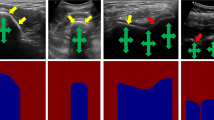Abstract
Purpose
Precise localization of cystic bone lesions is crucial for osteolytic bone tumor surgery. Recently, there is a move toward ultrasound imaging over plain radiographs (X-rays) for intra-operative navigation due to the radiation-free and cost-effectiveness of the modality. In this process, the intra-operative bone model reconstructed from the segmented ultrasound image is registered with the pre-operative bone model. Deep learning approaches have recently shown remarkable success in bone surface segmentation from ultrasound images. However, to train deep learning models effectively with limited dataset size, data augmentation is essential. This study investigates the applicability of the generative approach for data augmentation as well as identifies standard data augmentation approaches for bone surface segmentation from ultrasound images.
Methods
The generative approach we used in our work is based on Pix2Pix image-to-image translation network. We have proposed a multiple-snapshot approach, which mitigates the uni-modal deterministic output issue in the Pix2Pix network without using any complex architecture and training process. We also identified standard data augmentation approaches necessary for ultrasound bone surface segmentation through experiments.
Results
We have evaluated our networks using 800 ultrasound images from trained regions (humerus bone) and 1200 ultrasound images from untrained regions (tibia and femur bones) using four different augmentation approaches. The results show that the generative augmentation approach has a positive impact on accuracy in both trained (+ 4.88%) and untrained regions (+ 25.84%) compared to using only standard augmentations. Moreover, compared to standard augmentation approaches, the addition of the generative augmentation approach also showed a similar trend in both trained (+ 8.74%) and untrained (+ 11.55%) regions.
Conclusion
Generative approaches are very beneficial for data augmentation, where limited dataset size is prevalent, such as ultrasound bone segmentation. The proposed multiple-snapshot Pix2Pix approach has the potential to generate multimodal images, which enlarges the dataset considerably.










Similar content being viewed by others
References
Soeharno H, Povegliano L, Choong PF (2018) Multimodal treatment of bone metastasis–A surgical perspective. Front Endocrinol 9:518. https://doi.org/10.3389/fendo.2018.00518
Jung EM, Friedrich C, Hoffstetter P, Dendl LM, Klebl F, Agha A, Wiggermann P, Stroszcynski C, Schreyer AG (2012) Volume navigation with contrast enhanced ultrasound and image fusion for percutaneous interventions: first results. PLoS ONE 7(3):e33956. https://doi.org/10.1371/journal.pone.0033956
Jia R, Mellon SJ, Hansjee S, Monk AP, Murray DW, Noble JA(2016) Automatic bone segmentation in ultrasound images using local phase features and dynamic programming. In: 2016 IEEE 13th international symposium on biomedical imaging (ISBI), pp 1005–1008. IEEE. https://doi.org/10.1109/ISBI.2016.7493435
Baka N, Leenstra S, van Walsum T (2017) Random forest-based bone segmentation in ultrasound. Ultrasound Med Biol 43(10):2426–2437. https://doi.org/10.1016/j.ultrasmedbio.2017.04.022
Quader N, Hodgson A, Abugharbieh R (2014) Confidence weighted local phase features for robust bone surface segmentation in ultrasound. In: Workshop on clinical image-based procedures. Springer, Cham, pp 76–83 https://doi.org/10.1007/978-3-319-13909-8_10
Hacihaliloglu I (2017) Ultrasound imaging and segmentation of bone surfaces: a review. Technology 5(02):74–80. https://doi.org/10.1142/S2339547817300049
Salehi M, Prevost R, Moctezuma JL, Navab N, Wein W (2017). Precise ultrasound bone registration with learning-based segmentation and speed of sound calibration. In: International conference on medical image computing and computer-assisted intervention. Springer, Cham, pp 682–690 https://doi.org/10.1007/978-3-319-66185-8_77
Krizhevsky A, Sutskever I, Hinton GE (2012) Imagenet classification with deep convolutional neural networks. In: Advances in neural information processing systems. pp. 1097–1105. https://doi.org/10.1145/3065386
Goodfellow I, Pouget-Abadie J, Mirza M, Xu B, Warde-Farley D, Ozair S, Bengio Y (2014) Generative adversarial nets. In: Advances in neural information processing systems. pp 2672–2680
Antoniou A, Storkey A, Edwards H (2017) Data augmentation generative adversarial networks. arXiv preprint arXiv:1711.04340
Bowles C, Chen L, Guerrero R, Bentley P, Gunn R, Hammers A, Rueckert D (2018) GAN augmentation: augmenting training data using generative adversarial networks. arXiv preprint arXiv:1810.10863
Shin HC, Tenenholtz NA, Rogers JK, Schwarz CG, Senjem ML, Gunter JL, Michalski M (2018) Medical image synthesis for data augmentation and anonymization using generative adversarial networks. In: International workshop on simulation and synthesis in medical imaging. Springer, Cham, pp 1–11 https://doi.org/10.1007/978-3-030-00536-8_1
Frid-Adar M, Diamant I, Klang E, Amitai M, Goldberger J, Greenspan H (2018) GAN-based synthetic medical image augmentation for increased CNN performance in liver lesion classification. Neurocomputing 321:321–331. https://doi.org/10.1016/j.neucom.2018.09.013
Isola P, Zhu JY, Zhou T, Efros AA (2017) Image-to-image translation with conditional adversarial networks. In: Proceedings of the IEEE conference on computer vision and pattern recognition. pp 1125–1134 https://doi.org/10.1109/CVPR.2017.632
Mirza M, Osindero S (2014) Conditional generative adversarial nets. arXiv preprint arXiv:1411.1784
Zhu JY, Zhang R, Pathak D, Darrell T, Efros AA, Wang O, Shechtman E (2017) Toward multimodal image-to-image translation. In: Advances in neural information processing systems (pp 465–476)
Ronneberger O, Fischer P, Brox T (2015) U-net: convolutional networks for biomedical image segmentation. In: International conference on medical image computing and computer-assisted intervention. Springer, Cham, pp 234–241 https://doi.org/10.1007/978-3-319-24574-4_28
Kingma DP, Ba J (2014) Adam: a method for stochastic optimization. arXiv preprint arXiv:1412.6980
Sun C, Shrivastava A, Singh S, Gupta A (2017) Revisiting unreasonable effectiveness of data in deep learning era. In: Proceedings of the IEEE international conference on computer vision. pp 843–852 https://doi.org/10.1109/ICCV.2017.97
Acknowledgements
This material is based upon work supported by the Ministry of Trade Industry & Energy (MOTIE, Korea), Ministry of Science & ICT (MSIT, Korea), Ministry of Health & Welfare (MOHW, Korea) under Technology Development Program for AI-Bio-Robot-Medicine Convergence (20001234), and Kyungpook National University, Daegu, South Korea.
Author information
Authors and Affiliations
Corresponding author
Ethics declarations
Conflict of interest
The authors declare that they have no conflict of interest.
Ethical approval
All procedures performed in studies involving human participants were in accordance with the ethical standards of the institutional and/or national research committee and with the 1964 Helsinki declaration and its later amendments or comparable ethical standards.
Informed consent
Informed consent was obtained from all individual participants included in this study.
Additional information
Publisher's Note
Springer Nature remains neutral with regard to jurisdictional claims in published maps and institutional affiliations.
Rights and permissions
About this article
Cite this article
Zaman, A., Park, S.H., Bang, H. et al. Generative approach for data augmentation for deep learning-based bone surface segmentation from ultrasound images. Int J CARS 15, 931–941 (2020). https://doi.org/10.1007/s11548-020-02192-1
Received:
Accepted:
Published:
Issue Date:
DOI: https://doi.org/10.1007/s11548-020-02192-1




